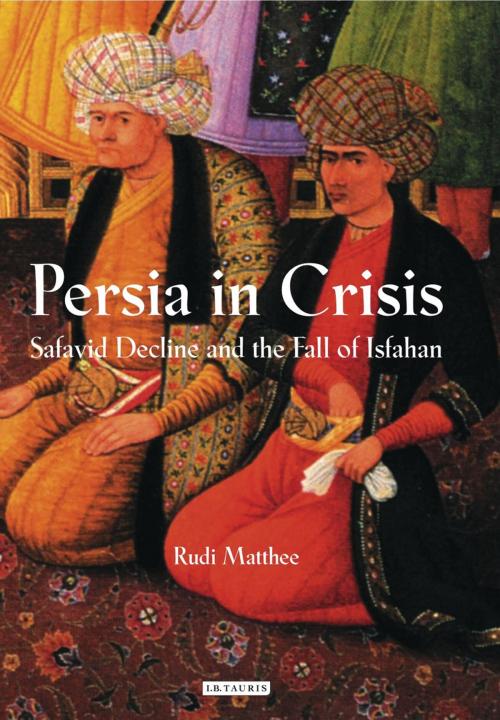Persia in Crisis
Safavid Decline and the Fall of Isfahan
Nonfiction, History, Modern, 18th Century, Middle East| Author: | Rudi Matthee | ISBN: | 9780857731814 |
| Publisher: | Bloomsbury Publishing | Publication: | November 30, 2011 |
| Imprint: | I.B. Tauris | Language: | English |
| Author: | Rudi Matthee |
| ISBN: | 9780857731814 |
| Publisher: | Bloomsbury Publishing |
| Publication: | November 30, 2011 |
| Imprint: | I.B. Tauris |
| Language: | English |
The decline and fall of Safavid Iran is traditionally seen as the natural outcome of the unrelieved political stagnation and moral degeneration which characterised late Safavid Iran. Persia in Crisis challenges this view.
In this groundbreaking new book, Rudi Matthee revisits traditional sources and introduces new ones to take a fresh look at Safavid Iran in the century preceding the fall of Isfahan in 1722, which brought down the dynasty and ushered in a long period of turbulence in Iranian history. Inherently vulnerable because of the country's physical environment, its tribal makeup and a small economic base, the Safavid state was fatally weakened over the course of the seventeenth century. Matthee views Safavid Iran as a network of precarious alliances subject to perpetual negotiation. The society they ruled was an uneasy balance between conflicting forces - a harsh physical geography, a heavily tribal population, a weak economic base, and endemic political factionalism against a strong ideology integrating faith and territory, an inclusive political system and, above all, the galvanizing effect of a forceful shah able and willing to transcend particular interests.
In the later seventeenth century this delicate balance shifted from cohesion to fragmentation. Matthee identifies the manifestations of political weakness and economic retrenchment that contributed to a slow unravelling of the threads of legitimacy and loyalty, thus undermining political control, which he argues cannot simply be attributed to the moral degeneracy of the elite or to foreign pressure. On the contrary, Persia in Crisis demonstrates that even the last few shahs were served by competent administrators who thought up policies to address the mounting problems. Yet these were unable to stem political mismanagement and reverse the state's growing insolvency. An increasingly detached, palace-bound shah; a weakening link between the capital and the outlying provinces; the regime's neglect of the military and its short-sighted monetary policies combined to exacerbate rather than redress existing problems, leaving the country with a ruler too feeble to hold factionalism and corruption in check and a military unable to defend its borders against outside attack by Afghans, Baluchis, Ottomans and Russians. The scene was set for the crisis of 1722.
This book makes a major contribution to our understanding of Iranian history and the period that led to two hundred years of decline and eclipse for Iran.
The decline and fall of Safavid Iran is traditionally seen as the natural outcome of the unrelieved political stagnation and moral degeneration which characterised late Safavid Iran. Persia in Crisis challenges this view.
In this groundbreaking new book, Rudi Matthee revisits traditional sources and introduces new ones to take a fresh look at Safavid Iran in the century preceding the fall of Isfahan in 1722, which brought down the dynasty and ushered in a long period of turbulence in Iranian history. Inherently vulnerable because of the country's physical environment, its tribal makeup and a small economic base, the Safavid state was fatally weakened over the course of the seventeenth century. Matthee views Safavid Iran as a network of precarious alliances subject to perpetual negotiation. The society they ruled was an uneasy balance between conflicting forces - a harsh physical geography, a heavily tribal population, a weak economic base, and endemic political factionalism against a strong ideology integrating faith and territory, an inclusive political system and, above all, the galvanizing effect of a forceful shah able and willing to transcend particular interests.
In the later seventeenth century this delicate balance shifted from cohesion to fragmentation. Matthee identifies the manifestations of political weakness and economic retrenchment that contributed to a slow unravelling of the threads of legitimacy and loyalty, thus undermining political control, which he argues cannot simply be attributed to the moral degeneracy of the elite or to foreign pressure. On the contrary, Persia in Crisis demonstrates that even the last few shahs were served by competent administrators who thought up policies to address the mounting problems. Yet these were unable to stem political mismanagement and reverse the state's growing insolvency. An increasingly detached, palace-bound shah; a weakening link between the capital and the outlying provinces; the regime's neglect of the military and its short-sighted monetary policies combined to exacerbate rather than redress existing problems, leaving the country with a ruler too feeble to hold factionalism and corruption in check and a military unable to defend its borders against outside attack by Afghans, Baluchis, Ottomans and Russians. The scene was set for the crisis of 1722.
This book makes a major contribution to our understanding of Iranian history and the period that led to two hundred years of decline and eclipse for Iran.















